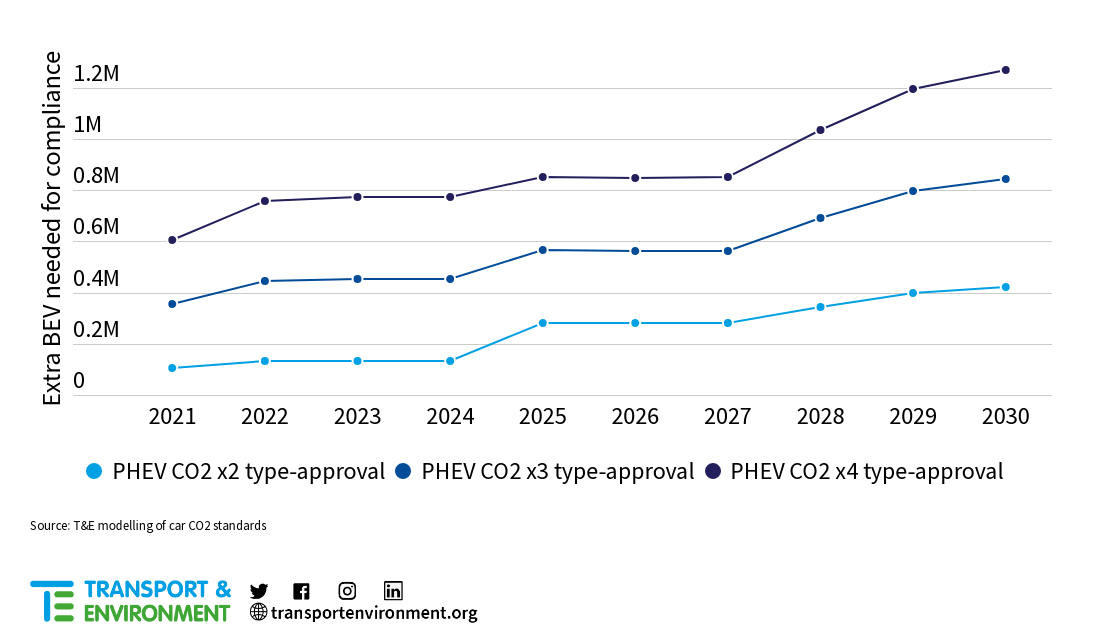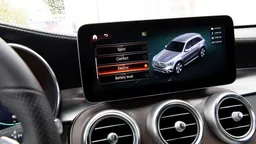PHEV sales have exploded in recent years with almost 1 million PHEVs sold in the EU in 2021. Carmakers are pushing their sales as their unrealistically low official CO2 emissions allow them to easily meet their CO2 targets. Yet PHEVs do not deliver the expected CO2 savings on the road due to both their poor design and lack of incentives to charge. Real world CO2 emissions of plug-in hybrids (PHEVs) are on average 2-4 times higher than official values. This undermines the credibility of the car CO2 regulation as well as of Europe’s wider climate efforts.
T&E calculates that – depending on how large PHEV CO2 emissions are in real world conditions – between 105,000-606,000 fewer ZEV models were sold last year than if PHEV’s official CO2 values reflected real world figures. If this continues, a middle of the road assumption suggests around 5.3 million fewer zero emission cars will be sold between 2022-2030. But unrealistic PHEV CO2 emissions don’t just hurt efforts to decarbonise transport, they also hit consumers with much higher fuel bills than expected undermining trust in a technology in which EU carmakers such as BMW are leaders.

Figure 1: Forecast of loss of EU27 BEV sales due to unrealistically low PHEV CO2 emissions. The modeling shows three scenarios where PHEV CO2 emissions are between 2-4 times higher than official figures.
At the heart of the problem are so-called utility factors (UFs)- overly optimistic assumptions of the share of kilometers driven electrically. Due to a lack of data at the time, these were not set on real world PHEV use but on conventional internal combustion engine (ICE) cars and are not representative of real world PHEV use resulting in artificially low CO2 emissions.
To tackle the problem the Commission has finally published a draft new methodology for determining utility factors which will be part of the Euro 6e Implementing Act. However, the Commission’s proposal lacks the necessary ambition to tackle the problem of PHEVs head on, proposing only small incremental improvements to UFs from the mid 2020’s with UFs which fully reflect real world PHEV use not implemented until the late 2020’s or even 2030.
Delaying implementation of real world UFs until the late 2020’s is not credible as PHEVs are a problem now. Every year that real world UFs are delayed, over a million PHEVs will be sold. By 2030, this will result in almost 11 mln suboptimal PHEVs sold across the EU. These will stay on the road for decades, emitting several times more CO2 than official figures thereby making it harder for Member States and the EU to meet their climate goals. With PHEVs sales expected to peak at around 1.45 million in 2025/2026 it is critical that ambitious action to fix the problem of UFs takes place no later than the middle of this decade.
The slow pace of change is also disappointing given that the data necessary to set real world UFs (from on-bard fuel consumption meters (OBFCM)) will be available to the Commission from April 2022 (with more data coming in 2023, and annually thereafter). Therefore, there is no reason to delay real world UFs until the late 2020’s, implementation sooner in 2025 is possible as the datasets can be analysed and ready by early-2023 latest. As T&E has already detailed in a previous briefing (Fixing the PHEV loophole) the Commission will have enough of this data in 2022 to determine real world UFs. If just 3% of EU PHEVs registered in 2021 transmit OBFCM records, 26,730 records will be received by the Commission. This is almost twenty times more data points than the 1,400 internal combustion engine vehicle records used for the development of the current highly flawed WLTP UFs. In case there are any unexpected data issues, the Commission can also use the ICCT/Fraunhofer UF as a backstop in 2025 instead of the late 2020’s as planned.
2025 is also a realistic timeline for carmakers as, unlike other car regulations such as new emission standards, changes to UF do not require vehicle engineering changes. An update of UFs simply fixes an erroneous calculation for determining CO2 emissions, it does not change the tests or require vehicle updates. This means that regulatory updates to PHEV UF can happen quickly. As the ongoing semiconductor crisis has shown, carmakers can tweak and ramp up both EV and conventional model production quickly when needed. Battery electric car sales reached 9.1% this year, much higher than the 6.8% forecast driven by carmakers focusing sales on more profitable models with higher CO2 emissions so more BEV’s had to be sold for car makers to comply with CO2 targets.
Therefore T&E calls on the Commission to revise it’s proposed update of UF to ensure that:
- Real world utility factors based on data collected from on-board fuel consumption meters are used for the calculation of PHEV CO2 emissions and for compliance with fleet CO2 standards no later than 2025.
- Utility factors are updated regularly in line with the frequency with which the Commission receives updated OBFCM data from the EU fleet. This will ensure PHEV CO2 emissions continue to reflect real world values and to allow car makers to benefit from improvements to the technology.
To find out more, download the briefing.


